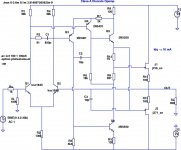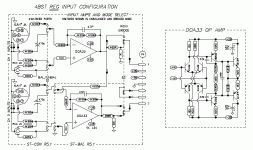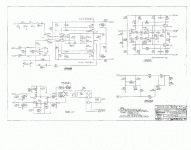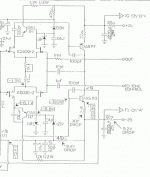No, please do NOT use those devices: Use J113, J175 devices.
OK, I need to dig up the Spice models of the J113/J175. Meanwhile, I plugged in the J310/J271 instead as the output stage of the venerable Melcor 1731, and it doesn't look terribly bad for 6+2 actives: GBW of ~3 MHz. Degeneration can be added, LTP compensation changed, etc., to improve this.
Attachments
OK, I need to dig up the Spice models of the J113/J175. Meanwhile, I plugged in the J310/J271 instead as the output stage of the venerable Melcor 1731, and it doesn't look terribly bad for 6+2 actives: GBW of ~3 MHz. Degeneration can be added, LTP compensation changed, etc., to improve this.
I was wondering when someone was going to grab one of the professional discrete opamps. API2520 anyone? DOA-12, DOA-17 from Five Fish... etc.
Maybe we should make it fit the pro plugin format of 1.1" square?
Too much yapping about dies and other things and not enough modeling!
2mv untrimmed...wait till you start finding thermal response issues in the 10 to 100 millisecond realm..then you'll come crying to the die people.
jn
2mv untrimmed...wait till you start finding thermal response issues in the 10 to 100 millisecond realm..then you'll come crying to the die people.Plastic just doesn't have a high diffusion velocity...
jn
Fortunately for me, I don't know what this means!
(except that it sounds bad)
Fortunately for me, I don't know what this means!
(except that it sounds bad)
Da#n..I was sipping coffee...
As a die pulls current, it heats up a bit. The best thing would be for both die to be thermally in contact with each other to minimize the change of one vs the other. I recall somebody actually epoxying a temp monitor to the top surface of some power chips to do this, though I don't like that...
Thermally, it takes about 100 uSec to 10 milliseconds for the thermal wave to make it to the substrate a die is attached to, under that time frame no external parts can sense a temp rise directly to comp the circuit.
The LM 194 transistor pair was the ultimate in this regard, as it had two pairs of transistors, cross connected on the chip. This prevented thermal gradients from affecting the performance, made for some good matching.
jn
My work back in the day was with mil spec hybrids, so laser scribing was a definite no-no...we had to pass PIND testing.
jn
Have you seen the femto-second laser cutting? Too fast for the phonons.
Da#n..I was sipping coffee...
As a die pulls current, it heats up a bit. The best thing would be for both die to be thermally in contact with each other to minimize the change of one vs the other. I recall somebody actually epoxying a temp monitor to the top surface of some power chips to do this, though I don't like that...
Thermally, it takes about 100 uSec to 10 milliseconds for the thermal wave to make it to the substrate a die is attached to, under that time frame no external parts can sense a temp rise directly to comp the circuit.
The LM 194 transistor pair was the ultimate in this regard, as it had two pairs of transistors, cross connected on the chip. This prevented thermal gradients from affecting the performance, made for some good matching.
jn
HAHA.
OK, but I don't think they make power transistors like this, do they?
I would assume that the input differential pairs would be monolithic if possible. For example, I know that I can get current mirrors (SMD) that are in one unit with 3 really tiny tabs. I do know that PNP and NPN transistor pairs are available as one unit also, but I do not know if jeft's are available like that any more. So, maybe have to change the circuit to bipolar inputs in order to take advantage of monolithic construction and stability? somebody? anybody?
I'm virtually certain that the two DOA's from Five Fish use monolithic transistor pairs at the input stage. I'm just not sure about getting complementary sets (I mean an NPN monolithic pair that are a complement to another PNP monolithic pair).
I've posted this link before and got no responses.
Linear Integrated Systems - Products
They make monolithic transistor pairs but they don't say if they are complementary sets.
If not, then the topology for the DOA has to be changed.
I don't think so. Gluing a comp chip on top, yes.HAHA.
OK, but I don't think they make power transistors like this, do they?
Using chips on board would be thermally the fastest, it just requires bonding the wires to the copper traces. Many manu's currently do it, then glob top them. The tech is pretty good now, so it's rather reliable.
It'd be great to find a house out there willing to do small scale proto's using a design created in this thread..
It also allows pre-matching of any device type for use on the front end.. And man, the component density increase would allow major circuits on the same real estate over smt.
jn
Last edited:
The JLH design in #306 is an interesting and useful design, both to talk about, and to upgrade to newer devices.
The original parts made by Motorola were available since the very late '60's and were the FIRST 'complementary' pair easily available. I used them for complementary jfet followers in 1970, and within a year developed the complementary differential jfet input stage with them. However, by 1972, Siliconix came out with better, higher Gm devices that appear today as the J113 and J175, derived from the NC and PS geometry that they developed. Unfortunately, due to mobility differences between the N and P channel material, the N channel jfets had about twice the Gm as the P channel.
Later, much later, when Toshiba introduced its line of complementary fets, they compensated for this by making the P channel larger to get a better Gm match, losing parasitic capacitance similarity, unfortunately, but a better overall combination, that we have run with for about 1/3 century, and now we are losing out.
The original parts made by Motorola were available since the very late '60's and were the FIRST 'complementary' pair easily available. I used them for complementary jfet followers in 1970, and within a year developed the complementary differential jfet input stage with them. However, by 1972, Siliconix came out with better, higher Gm devices that appear today as the J113 and J175, derived from the NC and PS geometry that they developed. Unfortunately, due to mobility differences between the N and P channel material, the N channel jfets had about twice the Gm as the P channel.
Later, much later, when Toshiba introduced its line of complementary fets, they compensated for this by making the P channel larger to get a better Gm match, losing parasitic capacitance similarity, unfortunately, but a better overall combination, that we have run with for about 1/3 century, and now we are losing out.
Over the years (decades actually) a lot of sorting of circuit topologies and their issues has occured. From various people they all sort of naturally, on their own, converged on the same topology. I trust this would indicate the topology which is the best one. At least for linear, audio circuits. Then it is a matter of using the best transistors in that topology.
Last edited:
Over the years (decades actually) a lot of sorting of circuit topologies and their issues has occured. From various people they all sort of naturally, on their own, converged on the same topology. I trust this would indicate the topology which is the best one. At least for linear, audio circuits. Then it is a matter of using the best transistors in that topology.
I guess also now that the topology has to reflect what kind of parts are available? So, there's another limitation.
The IT120 and IT130 families appear to be complements.
http://www.linearsystems.com/datasheets/LSIT120-2.pdf
http://www.linearsystems.com/datasheets/LSIT130-2.pdf
Some of the other dual monolithic transistors made by Linear Systems appear to be complements as well.
Last edited:
On Semi (iirc) [Edit: I'm thinking it was someone else; Sanyo? Sanken??) made some power transistors with on-chip diodes for more intimate temperature sensing. They may still be available, but clearly did not take the marketplace by storm.I don't think so. Gluing a comp chip on top, yes.
Using chips on board would be thermally the fastest, it just requires bonding the wires to the copper traces. Many manu's currently do it, then glob top them. The tech is pretty good now, so it's rather reliable.
It'd be great to find a house out there willing to do small scale proto's using a design created in this thread..
It also allows pre-matching of any device type for use on the front end.. And man, the component density increase would allow major circuits on the same real estate over smt.
jn
It would have been nice if they had continued the process by making similar smaller devices available (Dave McCorkle complained about this to me, then admitted that he was hard to please
Another intriguing device family that Motorola experimented with was a DMOS part with a cell or two of the source brought out on a separate pin. In principle one could use this for nearly lossless current sensing, or linearization games. This was circa 1990, and I don't know if On Semi (who took over Moto's discretes business) still makes them.
For diy, or cost-little-object high-endish designs, we have the options of operating the active devices in equidissipational complementary fashion, which is the "standard" 'scope vertical amplifier tradition, or even isodissipational, the latter being ~easy to do if the circuit has only two stable states; I made clock driver circuits that latter way circa 1977, and disclosed them in 1982.
Last edited:
On Semi (iirc) [Edit: I'm thinking it was someone else; Sanyo? Sanken??) made some power transistors with on-chip diodes for more intimate temperature sensing. They may still be available, but clearly did not take the marketplace by storm.
Sanyo still makes them. The SAP15, 16 devices also had on-chip 0.22 ohm Re's which, unfortunately, had smaller SOAs than the transistor it self (which actually are darlingtons) and the later versions no longer have the Re. These are the STD03 type. There are N and P versions, and the build-in diodes differ in each to make the bias spreader assymmetric further enhancing compementarity.
Toshiba also made a version of their BJT powers with build in what appears 1N400x type diodes.
These devices are relatively unknown in the diyaudio world but they have a good market for OEMs
Another intriguing device family that Motorola experimented with was a DMOS part with a cell or two of the source brought out on a separate pin. In principle one could use this for nearly lossless current sensing, or linearization games. This was circa 1990, and I don't know if On Semi (who took over Moto's discretes business) still makes them.
SenseFET was the marketing term. I believe they still make them.
Edit: Yes, see http://www.nxp.com/documents/application_note/AN10322.pdf for instance.
jan
Last edited:
Thanks Jan! Yes, I fished through email and found that it was On Semi that I'd seen first, although the link to the Electronic Products issue has long expired. And I remember that bit about the Sanyo on-chip 220mohm resistors that tended to blow upSanyo still makes them. The SAP15, 16 devices also had on-chip 0.22 ohm Re's which, unfortunately, had smaller SOAs than the transistor it self (which actually are darlingtons) and the later versions no longer have the Re. These are the STD03 type. There are N and P versions, and the build-in diodes differ in each to make the bias spreader assymmetric further enhancing compementarity.
Toshiba also made a version of their BJT powers with build in what appears 1N400x type diodes.
These devices are relatively unknown in the diyaudio world but they have a good market for OEMs
SenseFET was the marketing term. I believe they still make them.
Edit: Yes, see http://www.nxp.com/documents/application_note/AN10322.pdf for instance.
jan
EDIT: I also remembered the suggested circuits, which I immediately wanted to do differently
A cool thing (npi) would be to infrared-image the die and use that information. Certainly could be fast response
Brad
Last edited:
Over the years (decades actually) a lot of sorting of circuit topologies and their issues has occured. From various people they all sort of naturally, on their own, converged on the same topology. I trust this would indicate the topology which is the best one. At least for linear, audio circuits. Then it is a matter of using the best transistors in that topology.
It would be useful to differentiate on issues rather than fashion or just being different. I'm afraid of when the "listening" starts, very afraid.
A cool thing (npi) would be to infrared-image the die and use that information. Certainly could be fast response
Brad
You could drill a hole (TO-3) just big enough for one of those cheap IR sensors, I wonder how fast they are?
- Home
- Source & Line
- Analog Line Level
- Discrete Opamp Open Design



